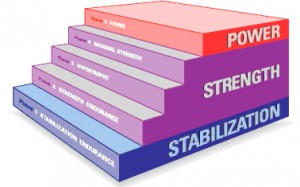By DeWayne Smith, MS, NASM-CES, PES, CNC
Gains don’t happen overnight. It takes your muscles time to respond and adapt to stimuli. Discover the resistance training program variables that will develop the strength gains and growth you or your client may be looking for.
- As a personal trainer, if you are unsure about how exactly to direct your clients’ strength training programming, this blog will be your guide.
- If you are studying to become a CPT, the concepts discussed within will help solidify the 3rd Phase of the OPT Model.
- And if you are a Bodybuilder or just wanting to learn more about the science behind hypertrophy, welcome!
WHAT IS GENERAL ADAPTATION SYNDROME?
Over time, our bodies adapt to the stimuli we expose them to. Broadly, these stimuli can range from environmental to physiological, and even be psychological. The adaptations to these stimuli fall under the phenomenon of General Adaptation Syndrome. As Hans Selye proposed, we all respond and adapt to stressors placed on us in a predictable manner. Muscle building is no different (1, 2).
If you’ve worked out hard, but often missed on ensuring proper recovery, you may have found yourself wondering why your results were marginal at best. Very often this is also the case with others who are finding it difficult to see results in building muscle. Looking at it through this lens, their bodies are not “adapting” the way they desire them to. In muscle building this desired adaptation is known as muscular hypertrophy.
THE FOUR BUILDING BLOCKS OF HYPERTROPHY
In order to define hypertrophy, an explanation of the Principles of Specificity, Overload, Adaptation, and Reversibility should come first.
1) The Principle of Specificity states that adaptations are specific to the stimuli provided.
2) The Principle of Overload is that in order for a tissue (bone, tendon, ligament, etc.) to adapt to a demand, it must be progressively overloaded.
3) The Principle of Adaptation is that the human body will adapt physiologically to the demands we place on it.
4) The Principle of Reversibility is that any gains are progressively lost when training is stopped (3).
WHAT DOES MUSCULAR HYPERTROPHY MEAN?
Muscular hypertrophy is an adaptation characterized by an increase in the cross-sectional diameter of muscle fibers that occurs as a response to those fibers being recruited to create increased levels of tension. More specifically, it is a function of protein balance (synthesis vs. breakdown) and consists of three mechanisms: muscle tension, muscle damage, and metabolic stress (3).
A BREAKDOWN OF MUSCLE TENSION
Muscle tension can be described by the mechanical tension placed on the muscle during an exercise, muscle damage by the eccentric load causing micro tearing and initiating the inflammatory response, and metabolic stress as a result of the buildup of various metabolites such as lactic acid (3). It is one of many adaptations experienced as a result of resistance training (Table 1).
TABLE 1. ADAPTIVE BENEFITS FROM RESISTANCE TRAINING (1,2)
Physiological
|
Performance
|
Psychological
|
Simply put, if you want your muscles to grow larger, you have to utilize the proper programming to elicit the required physiological response. In the NASM Optimum Performance Training ™ (OPT ™) model, hypertrophy is Phase 3 and is part of the strength level.  A hypertrophy phase workout consists of exercises utilizing low to intermediate repetition ranges with progressive overload. An example of this is 3-5 sets of 6-12 repetitions, performing the barbell chest press at 75-85% of the one repetition maximum (1RM) with a rest period of 1-2 minutes.
A hypertrophy phase workout consists of exercises utilizing low to intermediate repetition ranges with progressive overload. An example of this is 3-5 sets of 6-12 repetitions, performing the barbell chest press at 75-85% of the one repetition maximum (1RM) with a rest period of 1-2 minutes.
The combination of these acute variables provide the stimuli needed for muscular hypertrophy. Below (Table 2, 3) is a sample strength level, hypertrophy workout week based on a 2 day split routine. Ideally, these should be repeated for 3-4 weeks before progressing.
TABLE 2. MONDAY: CHEST/SHOULDERS/TRICEPS
| WARM-UP | Sets | Reps | Time |
| Self-myofascial Release | |||
| Pectoralis Major/Minor | 2 | 30s | |
| Upper Trapezius | 2 | 30s | |
| Latissimus Dorsi | 2 | 30s | |
| Dynamic Stretching | |||
| Push-up with Rotation | 2 | 15 | |
| Ball Cobra | 2 | 15 | |
| CORE, BALANCE, SAQ, and PLYOMETRIC | Sets | Reps | Tempo | Rest |
| Stability Ball Crunch | 2 | 15 | 0 | |
| Stability Ball Bridge | 2 | 15 | 0 | |
| Plank | 2 | 15s | 0 |
| RESISTANCE – horizontal loading | Sets | Reps | Tempo | Rest | |
| Chest |
|
3-5 | 6-12 | Controlled | 1-2min |
| Shoulders |
|
3-5 | 6-12 | Controlled | 1-2min |
| Triceps |
|
3-5 | 6-12 | Controlled | 1-2min |
| COOL DOWN |
|
TABLE 3. TUESDAY: BACK/BICEPS/LEGS
| WARM-UP | Sets | Reps | Time |
| Self-myofascial Release | |||
| Calves | 2 | 30s | |
| IT-Band | 2 | 30s | |
| Lats | 2 | 30s | |
| Dynamic Stretching | |||
| Prisoner Squat | 2 | 15 | |
| Ball Combo II | 2 | 15 | |
| CORE, BALANCE, SAQ, and PLYOMETRIC | Sets | Reps | Tempo | Rest |
| Single-leg Touchdown | 2 | 15 | 0 | |
| Stability Ball Bridge | 2 | 15 | 0 | |
| Plank | 2 | 15s | 0 |
| RESISTANCE – horizontal loading | Sets | Reps | Tempo | Rest | |
| Back |
|
3-5 | 6-12 | Controlled | 1-2min |
| Biceps |
|
3-5 | 6-12 | Controlled | 1-2min |
| Legs |
|
3-5 | 6-12 | Controlled | 1-2min |
| COOL DOWN |
|
In order to optimize results you should ensure you’re following appropriate nutritional and recovery guidelines (Table 4).
TABLE 4. NUTRITIONAL AND RECOVERY GUIDELINES FOR OPTIMIZING RESULTS (1 ,2)
| Caloric Intake | Positive Energy Balance |
| Recommended protein intake | 1.2 – 1.7g/kg Body Weight |
| Muscle Building and Recovery Strategies |
|
CONCLUDING THOUGHTS
In conclusion, muscular hypertrophy is nothing more than a physiological adaptation to imposed physical and metabolic demands. By creating that demand and optimizing the environment to build and recover on the cellular level, we see results.
It is not something that happens overnight, as initial results are usually seen in strength gain due to neuromuscular adaptation. However, several weeks later, changes in size may be noted. The key, as with many other endeavors, is consistency.

